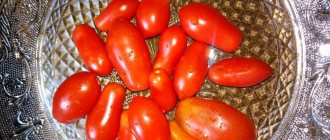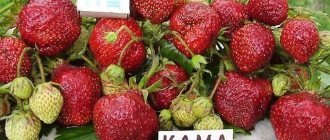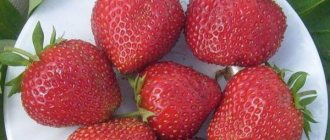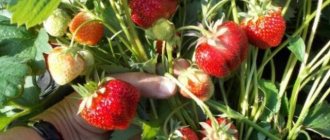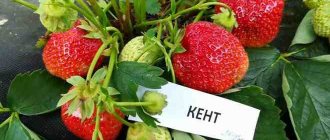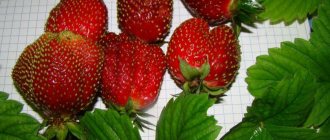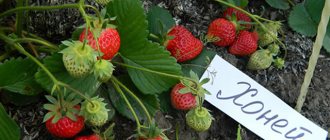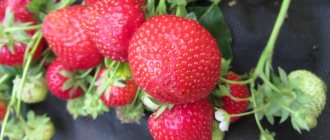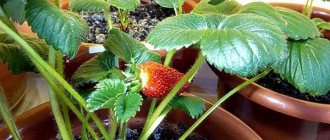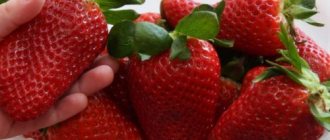Strawberry Symphony: a variety for the south and north
Many varieties of strawberries from foreign breeders were able to adapt well to the climatic conditions of Russia.
For several decades now, the Symphony strawberry, bred in Scotland in the last century (1997), has been successfully cultivated from Siberia and the Urals to the Caucasus and the Central European part of Russia. Such popularity is not surprising: the eminent parents - the varieties Holiday (compact bush, transportability of the berries) and Rhapsody (dessert taste, medium-late harvest) - passed on to their “daughter” many excellent characteristics. The Holiday variety also has famous parents. It was obtained by crossing the varieties Elsanta and Honey
Advantages and disadvantages of the variety
The obvious advantages of Symphony strawberries are reflected in the description of the variety, numerous photos and reviews from gardeners.
- Excellent dessert taste, large size and appetizing appearance;
- Consistent ripening and uniformity of fruits;
- Excellent yield of the variety, meeting the requirements of industrial cultivation;
- Unpretentiousness to weather conditions. Grows in hot and cold regions without defects for berries;
- High shelf life and transportability;
- The variety is resistant to verticillium blight, blight and gray rot.
Read also: Orlovskaya Amber cherry: description and characteristics of the variety
Some commentators consider the lack of remontant properties of the almost ideal strawberry variety Symphony to be a disadvantage.
Symphony strawberry bushes are powerful, with dense foliage. The root system is well developed, deepens to 25-35 cm. Large leaves are dark green, hard. Veins protrude from the bottom of the leaf blade. The shoots spread up to 40 cm, the shortened horns of peduncles are numerous. Peduncles are strong, slightly pubescent, with a large number of flowers.
Bright red, regular conical shaped berries of large and medium size. The skin is shiny. Symphony strawberry fruits are dense, fleshy, juicy. Sweet berries smell pleasant, like strawberries. Weigh 30-40 g. The seeds are deepened into the fruit, small, yellow.
Description of the variety
Strawberry Symphony is a medium-late ripening variety that can withstand cold weather. This is a non-repairing variety that was specially bred for short summers and cold winters. In the central zone of Russia, the variety bears fruit from the second half of June to the end of July. In warm regions, berries ripen 10-15 days earlier.
Bushes
Symphony garden strawberry bushes have medium vigor, dense foliage, and are beautiful. The leaf apparatus is hard, reaches 40 cm in height. The roots are branched, strong, and go up to 30 cm deep into the soil (for most varieties this figure is 12-15 cm). The peduncles are thin, multi-flowered, and lie down under the weight of the fruits. Educational ability is average.
Symphony matures about a week later than its “grandmother” Elsanta
Berries
The first fruits, weighing about 30 g, have a conical shape and are uniform (more than 49% of the fruits have a berry length of more than 35 mm), in subsequent harvests the berries become sharply smaller and are more suitable for preservation. An attractive presentation is created thanks to the shiny, dense dark red skin. The pulp has a fleshy structure, juicy with a strong aroma of wild berries. At the stage of technical ripeness, the tip is green, when fully ripened it turns red. The berries are easy to pick, the sepals come off with difficulty, and the berries do not wrinkle or flow.
The taste of Symphony strawberries is magnificent: sweet, with a slight sourness, as befits a dessert berry.
Productivity
Over the course of 1-2 months, 700-1000 g of fruits are removed from the Symphony bush. In the first season, the yield is no more than 500 g. The value of Symphony fruits is that they can remain suitable for consumption, even if they hang ripe for a long time. The yield of Symphony is 5-7% higher than Bogota strawberries, 20% higher than Cambridge Favorite, 40% higher than Elsanta.
Harvest Symphony is placed in wooden or corrugated cardboard containers in a single layer and left in a cool place. The product will definitely retain its freshness for a week
Tips for caring for strawberries
The longevity of strawberry bushes and their productivity depend on how the plants are cared for after planting.
Watering methods
Strawberry Symphony requires watering throughout the season. In spring, it is carried out in the morning in the form of sprinkling, so that by the evening the soil and leaves dry out and a favorable environment for the development of fungal diseases does not arise.
After the buds appear, watering must be carried out “at the root” or by drip method. The earth is moistened to a depth of 25 cm. Water for irrigation should be soft, moderately warm (about 18 ⁰C).
Wetting of the beds is carried out at the following intervals:
- in spring - weekly;
- in summer - once every 3 days;
- in autumn - three times a month.
Fertilizer
Periodic feeding of Symphony strawberries leads to an improvement in the condition of the bushes and an increase in the size of the berries. Experts recommend applying fertilizer according to the following scheme:
- 1st spring feeding - 25 g of nitroammophoska is dissolved in 10 liters of water and 0.5 liters are applied per plant;
- 2nd spring feeding - with organic matter (mullein is diluted in a ratio of 1:10 and 1 liter is used per plant);
- summer, during the period of setting berries - potassium-phosphorus + ash;
- after harvesting - organic and mineral fertilizing.
Mulching and loosening
Mulching the soil after watering, loosening and removing weeds allows you to maintain the structure of the soil, reduce moisture evaporation, and protect the roots from overheating. Sawdust, grass, straw, pine needles, and agricultural fabric are used as mulch. Thanks to the cover of the soil, fruiting of Symphony strawberries can occur at an earlier date.
What you need to know about winter care
Despite the high frost resistance of Symphony strawberries, they should be prepared for winter. To do this, the beds are additionally mulched with straw and dry leaves, bringing the layer to 10-15 cm. Thanks to this shelter, snow lingers on the beds in winter, and the roots are reliably protected from freezing.
a brief description of
Advantages of the variety
The Symphony variety of strawberries has a lot of positive aspects, otherwise it would not be able to compete with modern varieties:
- keeps a fresh look for a long time;
- great dessert taste;
- universal purpose of fruits;
- possibility of transportation over long distances;
- high productivity;
- simple agricultural cultivation technology;
- tolerates cold and heat well;
- resistance to most diseases, especially gray rot, powdery mildew, verticillium wilt, root rot;
- possibility of cultivation in the northern regions.
According to reviews from gardeners, the main significant disadvantage of the variety is its small fruit. There are many berries, but their shape and size do not allow the variety to be used for commercial purposes.
Pros and cons of the Symphony variety
The positive aspects of Symphony strawberries include the following qualities:
- large berries;
- uniform ripening of fruits;
- maintaining fresh appearance and taste when harvesting is delayed for several days;
- excellent dessert taste;
- versatility of the scope of application of fruits;
- attractive appearance;
- keeping quality;
- good transportability;
- high productivity;
- relative ease of care;
- resistance to unfavorable climatic conditions - the variety safely survives harsh winters and dry periods;
- resistance to most diseases;
- adaptability for growing in short-day conditions, thanks to which strawberries can be planted in the Northern regions.
There are no pronounced shortcomings in the Symphony variety of strawberries, however, some gardeners in reviews note the lack of remontant qualities as such.
Landing
It is better to plant Symphony strawberry plantations in late summer or spring, when the soil has warmed up well. In warm regions, autumn planting is preferable, since spring is short and young seedlings can “burn” in the sun. Planting in summer will be done with a minimum number of attacks if seedlings with ZKS were used.
The plots for strawberries are chosen to be flat, with good drainage. Damp and shaded places are absolutely not suitable for the Symphony. The composition of the soil is not important, but the variety will show the greatest productivity on fertile loams. The groundwater level should be more than 70 cm, acidity pH=5.2-5.5.
When preparing the site, the soil is dug up on the bayonet of a shovel and fertilizers are applied:
- a bucket of compost or humus;
- 130 g of potassium sulfate;
- 100 g superphosphate.
The specified amount of fertilizer is distributed per 1 m2. It is not advisable to plant bushes close, as Symphony quickly produces new horns. The minimum distance between plants in a row is 35 cm, between ribbons - 60 cm.
The depth of the hole is determined by the size of the rhizome, which should be located vertically when planting. The growth point where the stem and leaves emerge is left on the surface; the roots are not bent. The plant is watered abundantly and the bed is covered with mulch.
Growing
Strawberries are propagated by dividing the bushes and rooting the tendrils. As reported in the description of the Symphony strawberry variety, it is planted in August, September or April. Autumn planting makes it possible to harvest the first harvest next year. The site is prepared in advance. Six months before planting the strawberries, the soil is dug up and fertilized. For 1 sq. m take a bucket of humus or compost, 150 g of superphosphate, 100 g of potassium fertilizer.
Reproduction by divisions
Choose 3-4 year old Symphony strawberry bushes - well developed, with numerous horns and rosettes. They are dug up in spring or autumn and divided into parts.
- Each part must have long powerful roots, a horn, a rosette;
- In healthy seedlings, the apical bud is visible, the shoots are strong and have at least three leaves;
- You need to carefully consider the leaves of seedlings when purchasing. Their deformation and wrinkling are not allowed. Such defects may be signs of tick infestation.
Reproduction by mustache
Strawberries of the Symphony variety have a few mustaches. Most of all they are reproduced by a 2-3 year old bush. Planting material is selected from such plants.
- The tendril is cut off and placed in water with a solution of a root formation stimulator;
- When the roots and rosette are created, it can be transplanted into soft, nutritious soil;
- Water daily for 5 days to keep the soil wet;
- On the 6th day, the soil is mulched and not watered until the top layer dries;
- The seedling is placed on the site after 2 weeks.
Landing rules
Having prepared the seedlings and the plot, mark out the ribbons for the strawberries. The symphony grows quickly, scattering shoots to the sides, so the distance between the holes is 35 cm. If a two-line scheme is used, the distance is increased to 40 cm.
- The holes are dug to a depth that corresponds to the length of the roots and filled with water;
- Fertilize with a mixture of peat and humus, 1 part each;
- For better survival, pinch the longest root and cut off the leaves, leaving at least three;
- The rosette must be left on the surface;
- The top of the hole is mulched.
After planting in autumn or early spring, young Symphony strawberries are covered with film or spunbond to protect them from frost. If flower stalks appear in the spring, they are torn off, giving the root system a chance to strengthen. If there is insufficient rain, strawberries are watered, then the soil is loosened and mulched. Make sure that water does not get on the plant. Accordingly, drip irrigation is preferable for strawberries. It is especially important during flowering and berry filling.
- It is advisable to remove the autumn mulch in the spring from the top layer of soil, removing hidden pests at the same time;
- The soil from another area is enriched with humus, compost and sprinkled under Symphony bushes;
- Trim dry and damaged leaves from bushes;
- Leaves are removed after fruiting from bushes older than two years.
Top dressing
The Symphony variety needs regular fertilizer to grow large berries.
- In the spring, for each bush, give 0.5 liters of nitroammophoska solution (25 g per 10 liters of water);
- Another option for spring feeding: 1 liter of mullein solution (1:10) and ammonium sulfate. Chicken manure is diluted 1:15;
- During the formation of ovaries, Symphony strawberries are fed with wood ash, products with potassium, phosphorus or complex fertilizers: Master, Kemira. Carry out foliar feeding with boric acid;
- After fruiting, especially after mowing strawberry plants, the bushes are optionally fertilized with urea, organic matter, and mineral complexes.
Preparing for winter
Fertilized in August, the strengthened bushes enter winter. In late autumn, strawberries are mulched with straw, covered with dry branches, and spruce branches can be placed on top. The Symphony variety is winter-hardy, but if frosts drop below 25 degrees, especially without snow, the bushes must be covered with agrotex or straw. The material is pulled over branches or on low arches.
Growing and care
Before you start growing the Symphony variety, you need to familiarize yourself with some of the nuances of caring for the assortment, the observance of which determines the further growth and productivity of the plant.
Watering
Symphony garden strawberries are irrigated moderately. For greater efficiency, drip irrigation is suitable. The “droplet” will prevent water from getting on the foliage and fruits. Without taking into account extreme weather conditions, the frequency of watering is no more than 2 times a week.
It is best to organize watering in the morning and do it with warm water. During the period of ovary formation, the frequency of watering is increased
Loosening, weed control
At least once a week, the beds not covered with mulch are loosened (no deeper than 3-4 cm) and weeded. Weed control and loosening are one of the main agricultural techniques. During loosening, you must try not to damage the roots so that they do not become vulnerable to fungal diseases.
Subtleties of cultivation
To grow strong and productive strawberries, you need to know the rules for choosing planting material, the subtleties of agricultural technology and plant care.
Selection and preparation of a landing site
The place for planting strawberries must meet a number of requirements:
- light fertile soils with low groundwater levels;
- protection of the site from drafts and northern winds;
- slope to the south;
- soil cleared of weeds and pests.
Preparation of planting material
Its rooting and further growth depend on the choice of planting material. High-quality seedlings have a developed root system, strong, strong shoots with healthy leaves. They should be free of stains, plaque and wrinkles. Healthy roots are light-colored, without signs of disease.
For better survival, they must be immersed in a growth stimulator solution for 30 minutes.
Landing rules
When planting strawberries of the Symphony variety, you should perform a number of actions:
- Prepare the wells at a distance of 35 cm from each other for a single-line arrangement and 40 cm for a double-line arrangement.
- Add a substrate of peat and humus mixed in a 1:1 ratio.
- Spill holes.
- Pinch the longest root to stimulate lateral growth.
- Remove excess leaves, leaving 2-3 strongest ones.
- Plant the seedlings so that the growing point is above the soil surface.
- Water again.
- Mulch the soil.
Reproduction
Propagation of Symphony strawberries is possible in several ways:
- Dividing the bush. Three-year-old bushes are dug up early in spring or autumn, trying not to damage the roots. Shake off the soil and use a sharp knife to cut the bush into several parts. The parts are immediately seated and watered abundantly.
- Usami. The rosettes that form on the tendrils are rooted in plastic pots. During the summer, you need to ensure that the soil in the pots does not dry out. Seedlings with a closed root system are easier to transplant.
The first days, in hot weather, water the rooting rosettes twice a day. The soil must be constantly moist.
Diseases and pests
Despite the fact that the Symphony variety is resistant to many diseases, sometimes the plantings still get sick. Fungal diseases pose the greatest threat to plants.
Most often, landings affect:
- Black rot - expressed in the form of darkening and brittleness of the root system of plants. In this case, strawberries are treated with the preparations “Phytodoctor” and “Chorus”.
- Powdery mildew. The first sign of the disease is a whitish coating on the leaves and shoots of bushes. It is recommended to treat plants with Switch.
- Wilting, which usually appears in conditions of abnormal heat. The disease manifests itself in a change in the color of the shoots and whiskers to lighter colors. Treat wilt with any fungicides.
Among the pests of the variety, the following insects should be especially highlighted:
- nutcracker;
- nematodes;
- leaf beetles;
- mites;
- red ants;
- slugs and snails.
Prevention of diseases and pest damage is carried out in the spring and autumn after the harvest is harvested. In the spring, the top layer of soil, which may contain insect larvae and harmful fungal spores, is removed. Additionally, the area is sprayed with a solution of Bordeaux mixture or copper sulfate. Spraying is repeated in the fall.
Reviews
Symphony is a variety for lazy gardeners. I only go to the dacha on weekends; I don’t have the opportunity to regularly water, feed, or treat it. And Symphony grows well and without unnecessary interventions, without watering, the taste becomes even more intense. The berries are medium in size, there are no “cakes”, but they look very good in jam.
I got rid of Symphony and Sweet Anna. Yes, they are worthy varieties to taste, but in terms of the size of the berries and yield, they do not reach many modern varieties.
Berries of the Symphony variety can be grown for sale, as they have good shelf life and transportability, however, their small fruit size may confuse a potential buyer. Ripe fruits can be harvested within a few days without compromising quality. Gardeners value the variety primarily for its resistance to infections, which allows them to obtain a high-quality harvest without the use of dangerous fungicides.
Strawberry variety Symphony
Symphony is a non-repairing variety of garden strawberries (strawberries) of medium late ripening, for dessert use. It was developed in Scotland in 1979 by crossing the Rhapsody and Holiday varieties. Valued for its excellent taste, good yield, and productive longevity. Suitable for growing on a personal plot and on farms in small quantities.
The plant is powerful, multi-horned, abundantly leafy. The adaptation is average. The leaves are hard and dark green in color. The flowers are white, bisexual. Strawberry flower stalks are powerful, multi-flowered, with medium pubescence, spreading, and are formed in abundant quantities. Symphony can sometimes show signs of remontancy, under favorable weather conditions, but a second wave of fruiting will not give good results.
The variety's berries are medium to large in size, have a regular conical shape, and are distinguished by their uniformity. The skin is bright red and shiny. The achenes are small, yellow in color, and shallowly pressed. The pulp is uniformly colored bright red, dense, juicy, with a fleshy consistency, and aromatic. At the stage of technical ripeness, the tip of the fruit has a greenish color; when fully ripe, the entire berry turns red. The fruits are easily separated from the stalk, which has a positive effect on the speed of collection.
The taste of strawberries is excellent, the berries are sweet, with a slight hint of sourness, a true dessert taste. Symphony fruits are universal in use, suitable for any processing and freezing, and are excellent fresh. The berries tolerate transportation and short-term storage well, have an impressive presentation, so our heroine is suitable for growing for commercial purposes.
The average fruit weight per season is about 20−25 grams; at the first harvest, specimens weighing up to 40 grams can be observed. Strawberries bear fruit for a long time and are quite stable; the berries become slightly smaller towards the end of the season. Our heroine matures about a week later than Elsanta, on a par with Zenga Zengana. The yield of the variety is not outstanding - up to 700 grams of berries per bush, on average the figure fluctuates around 500 grams of fruits per plant.
Harvesting and storing strawberries
The harvest period lasts up to two months. The berries are resistant to precipitation and weather changes, and do not spoil in the ripe phase for several days while on the bush. After collection, they are placed in wooden containers and transferred to a cool place. The variety is easily transported and retains its commercial qualities for 5-7 days after collection. The purpose of the berry is universal. Can be used both fresh and for processing.
Good afternoon. I am interested in strawberries Symphony: description of the variety and reviews about it. I had never done gardening before and didn’t intend to, but I was at the dacha in the summer and through the fence I saw my neighbor’s large bright red berries. And I also wanted to plant strawberries. I won’t make jam, just for food (for myself and close friends in town). But I don't know which variety is better. A friend gave me advice, now I want to know your opinion.
For Symphony strawberries, the description of the variety is as follows: the berries are really medium and large, sweet and juicy. The yield is high, the ripening period is medium-late. They are resistant to diseases and are not afraid of heat and cold, but in winter it is better to cover the bushes so as not to endanger the plant.
What do they say about Strawberry Symphony? In general, the reviews are positive. Gardeners grow this variety for sale in retail outlets because the berries last a long time and do not spoil, and are also excellent for transportation. Strawberry lovers love the dessert taste, sweet aroma and large number of berries that can fill you up for the whole year. Women often use them for baking.
Symphony grows in one area for 4-7 years. Unpretentious, does not require careful care.
Description of the variety
Strawberry "Symphony" is the result of the work of Scottish breeders. Obtained in 1979 by crossing the varieties “Holiday” and “Rhapsody”. It belongs to the mid-late variety, that is, it does not ripen quite quickly, but it has other remarkable characteristics.
"Symphony" is an industrial grade. And such berries have several properties that are essential for them: excellent shelf life, transportability and the ability to harvest for several days without spoiling the berries on the bushes.
In amateur gardening, strawberries are loved for their remarkably sweet taste, high yield and some density - the berry does not lose its shape during storage. In addition, “Symphony” has another quality that is very useful for gardening in the middle northern regions of Russia: it is a short-day fruit, that is, it is adapted for ripening in conditions of relatively short and cool summers.
It is worth noting that “Symphony” does not belong to the refurbishment category. However, the extended ripening period gives the impression that the berry produces a harvest for 2 months. It is also worth reading about Zenga Zengana strawberries.
The video shows a description of the berry variety:
The remaining characteristics of the variety look like this:
- bush of medium size, multi-horned, powerful . There are many leaves, they are hard and dark;
- peduncles multi-flowered, powerful;
- the variety is a fruitful variety - already in the 2nd year you can harvest up to 700 g of berries from one bush;
- Strawberries ripen relatively late - later than Elsanta;
- the berries are large or medium - weighing up to 40 g, have the shape of a regular cone. The skin color is bright red, shiny, the flesh color is red, the flesh is evenly colored;
- taste – juicy, very sweet, meaty. Strawberries belong to the dessert category, and have the best taste when fresh; It is also worth learning more about what Albion strawberries taste like, for this you should follow the link and read the description.
- the fruits have very good shelf life, as befits an industrial variety, and tolerate transportation well;
- Strawberry seeds are small and yellow in color . With insufficient ripeness, the tip of the seed remains greenish;
- “Symphony” perfectly tolerates not only heat, but also drought, and is no less well adapted to long and cold winters. In general, this variety is considered one of the most unpretentious;
- Strawberries are resistant to verticillium, gray rot, fungal spots and other diseases.
What the Festival chamomile strawberry looks like, and what are the features of its cultivation, is described in this article.
And here you can read about existing reviews of Queen Elizabeth strawberries.
And here you can read a description of the Honey variety strawberries, and also see a photo.
The "Symphony" variety is long-lived. Plants live on one plantation for 5 years, the yield does not lose over time.
Characteristic
The durability and popularity of the mid-late strawberry variety Symphony is ensured by the extended harvest period for dessert berries. You can enjoy the magnificent looking fruits for almost two months, starting from the end of May or mid-June, which depends on the region. The Symphony variety is not remontant; it was bred for climatic conditions with frosty winters and short summers. And it meets the requirements with a harmonious composition of excellent taste, the ability to maintain an attractive appearance for a long time and resistance to harsh weather. The variety colonizes summer cottages and garden plots in the Urals and Siberia, enduring frosts with the help of gardeners.
According to reviews from gardeners, the strawberry variety Symphony keeps ripe berries on the bushes for a long time: they are picked for several days without fear that the appearance and structure of the pulp will deteriorate. They also remain in containers for some time during transportation and retain their commercial appeal. On average, each strawberry bush produces 2 kg of berries, less per year of planting. Harvests of Symphony strawberries in the second year, as stated in the description of the variety and in reviews, with good care reach 3.5 kg per bush. Thanks to these positive properties of the Symphony strawberry fruit, it is grown by large and small agricultural producers. The variety is also popular among amateur gardeners, because it can grow in one place for five years without losing productivity.
The Symphony variety is a dessert variety; berries with remarkable healing properties are best consumed fresh. The strawberry variety is widely represented in the retail chain due to its delicious appearance. The berries are used by the food industry and at home for jams, jams and other preparations. Excess firm berries can be frozen to preserve a bit of summer flavor for a winter's day.
How and when to plant
"Symphony" is propagated by dividing the bush or by tendrils, although the plant produces relatively few tendrils. However, the second method can be used if desired. The first method is trouble-free in cases where you need to transplant strawberries to a new place, the second is simpler and more accessible.
Sufficiently “mature” bushes are suitable for division - 3-4 years. In this case, the bushes should be well developed.
The technology of propagation by bushes is quite simple.
- In autumn or spring, the bushes are divided so that each part includes a horn with roots, a rosette, and each fragment is planted in a separate hole.
- Be sure to add organic fertilizer to each hole. A mixture of humus and peat in a 1:1 ratio is also suitable.
- The fertilizer is covered with a mound of earth, making sure that the soil remains loose.
- Part of the bush is placed in the hole, covered with earth and watered. The volume of water is determined by the degree of soil moisture. It is recommended to fill the area around the bush with mulch. It is also worth learning more about how the Lord strawberry variety is planted and grown.
Advantages and disadvantages of the variety
Symphony has quite a lot of advantages , thanks to which it is popular among lovers of growing strawberries:
- high productivity;
- large and juicy berries;
- adaptability to hot and cold weather;
- resistance to gray rot, verticillium, fungal diseases;
- shelf-stable fruits suitable for transportation.
The main disadvantage of this variety is that it produces a harvest only once a year.
Advantages of Symphony: high yield, shelf-stable fruits, suitable for transportation
Before you start planting a plant, you need to familiarize yourself with the features of this process.
When can you plant
You can plant strawberries at the end of summer, autumn or spring . In autumn, it is planted until mid-September so that the harvest can be harvested the following year.
In spring, strawberries can be planted immediately after the soil warms up . Many gardeners do this in late March or mid-April.
The variety can be planted in spring, summer and autumn
Site selection
To grow strawberries, you should choose a wind-protected and sunny area with black soil or forest soil.
Strawberries should not be planted in soil that contains a lot of clay.
It should have a developed root system, thick and strong shoots, an apical bud with three healthy leaves.
When choosing seedlings, you need to carefully examine its leaves. They should not be wrinkled or deformed. If there are any defects on them, this indicates a tick infestation.
It is not recommended to buy young seedlings with a poorly developed root system , since even with good care, a full harvest will appear only after a year.
For spring planting, seedlings should be purchased in early March, and for autumn planting - at the end of August.
Preparing the site for planting should be done before the start of winter. 5-10 kg of manure, 100 g of potassium salt and 150 g of superphosphate are added to it .
It is not recommended to place the holes too close, as the strawberries grow greatly. The distance between them should be at least 35 cm.
The depth depends on the development of the roots. They should fit freely in the holes vertically.
There are two ways to plant seedlings : in dry or watered soil.
To make the plant take root faster, you can pinch its longest root or trim off excess leaves .
To protect seedlings from sudden frosts, they can be covered with plastic wrap.
Strawberries grow strongly, the distance between bushes should be at least 35 cm
The main advantage of planting strawberries in the fall is that you can taste the harvest from young bushes next summer .
In the spring you should start preparing the site. The soil is carefully dug up and fertilized with humus. A week before planting, seedlings should be carefully examined.
There should be no disease or rot on the sprouts. After inspection, the roots should be treated with fungicides.
It is recommended to plant seedlings in the ground in early September . The holes are made deeper so that they do not freeze in winter. After placing the seedlings in the ground, the beds are watered.
Planting strawberries in autumn:
How to care
In general, the “Symphony” variety is unpretentious. Which, of course, does not mean that it does not need care.
A prerequisite, in addition to other procedures, is feeding. Although “Symphony” is not a large-fruited variety, it needs additional feeding, otherwise the berries become small.
- First of all, it is necessary in the spring to remove frozen plants, if any, also from dry leaves. If mulching was carried out in the fall, then the top layer of soil is removed - along with it, pests that overwintered in the soil are removed. After which you need to add a layer of soil, but a thin one, otherwise the roots will not grow for a long time.
Video shows how to care for strawberries:
If the autumn bedding remains, you need to carefully loosen the soil around the strawberry bushes to a depth of 7 cm.
- Caring for the “Symphony” variety requires at least 3 feedings.
- The third feeding is carried out after picking the berries. At the same time, organic matter and a mineral complex are introduced - Master, Kemira. You cannot delay fertilizing until late autumn: strawberries need some time to develop and prepare for the dormant period.
- After loosening or removing the bedding, the beds are sprinkled with straw, peat chips, sawdust, and humus. This way you can immediately feed the plants with nitrogen fertilizers.
When new leaves appear, under each bush it is necessary to add a solution of mullein - in a ratio of 1:10, and ammonium sulfate. In addition, in the month of May, it is necessary to apply mineral fertilizers with potassium and phosphorus. But how to care for Kimberly variety strawberries, what features this variety has, as well as what it looks like, can be seen here.
Water the crop at least once a week, preferably in the morning, with warm water. Before flowering, strawberries do not need to be watered, provided there is good rainfall. But when flowers and berries appear, watering is required. In this case, do not allow water to get on the leaves and berries.
Mulching is recommended: this creates a loose layer of material that retains moisture in the ground and does not allow weeds to multiply.
"Symphony" tolerates cold well. However, in severe frosts - below -25 C, you need to cover the strawberries with agrofibre or vegetable mulch.
But what the Darselect strawberry variety looks like and how it should be grown in your garden is described in detail in this video.
Diseases and pests
Despite the fact that the Symphony variety is resistant to many diseases, sometimes the plantings still get sick.
Fungal diseases pose the greatest threat to plants. Most often, landings affect:
- Black rot - expressed in the form of darkening and brittleness of the root system of plants. In this case, strawberries are treated with the preparations “Phytodoctor” and “Chorus”.
- Powdery mildew. The first sign of the disease is a whitish coating on the leaves and shoots of bushes. It is recommended to treat plants with Switch.
- Wilting, which usually appears in conditions of abnormal heat. The disease manifests itself in a change in the color of the shoots and whiskers to lighter colors. Treat wilt with any fungicides.
Among the pests of the variety, the following insects should be especially highlighted:
- nutcracker;
- nematodes;
- leaf beetles;
- mites;
- red ants;
- slugs and snails.
Prevention of diseases and pest damage is carried out in the spring and autumn after the harvest is harvested. In the spring, the top layer of soil, which may contain insect larvae and harmful fungal spores, is removed. Additionally, the area is sprayed with a solution of Bordeaux mixture or copper sulfate. Spraying is repeated in the fall.
